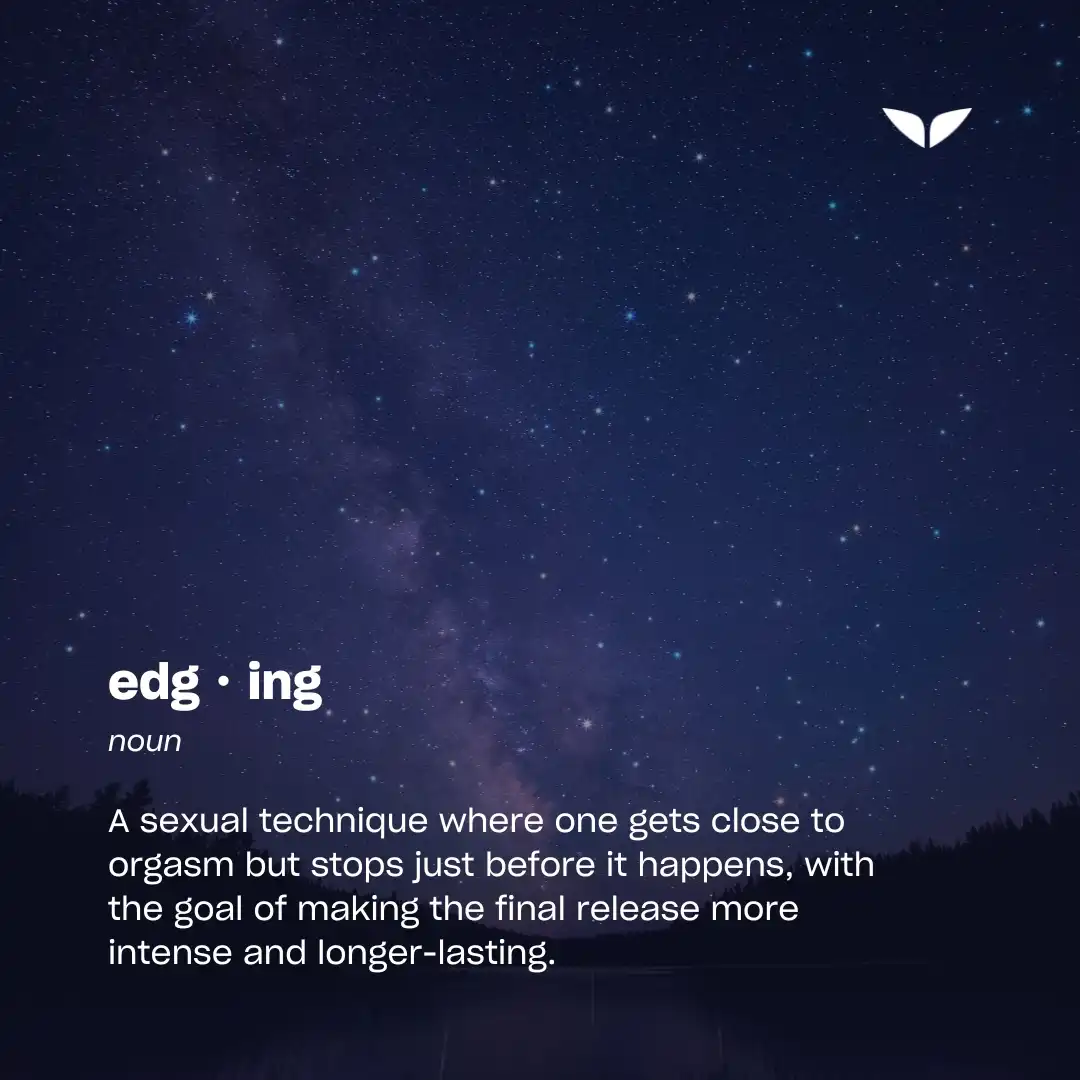Edging might be a landscaping terminology, but in the realm of pleasure, it’s far from trimming the bush. It’s also not flashy, doesn’t come with a playlist, and you won’t find it trending alongside rose quartz yoni eggs or the latest libido gummies.
For all the things that it’s not, though, edging is a practice quietly gaining traction among the curious and the conscious. And its reputation is starting to shift from niche kink to mindful mastery.
Edging is designed to expand your orgasmic potential.
— Layla Martin, trainer of Mindvalley’s Neo-Tantra: Discovering Energy Orgasms and Deepening Your Sexual Connection program
No, it’s not new. It’s just been hiding behind bad sex ed, porn tropes, and a collective impatience to get things over with.
Maybe you’ve been skipping the buildup without realizing what it’s trying to teach you. And perhaps knowing what it can do to your body, your brain, and your connection with another person will help make you come around.
What is edging?
The “edging” meaning, in essence, is bringing yourself (or your partner) to the brink of orgasm, then backing off before climax. The focus, really, is on staying just below the tipping point. The result is a kind of prolonged crescendo, where each wave of sensation sharpens the next.
It’s a tool, really, “designed to expand your orgasmic potential,” as Layla Martin, a tantra and intimacy coach, explains in her Neo-Tantra program on Mindvalley.
And what it does is “it trains your nervous system to be able to hold more pleasure, more turn-on, and more energy and excitement in your [nervous] system before you feel the need to release, a.k.a., have an orgasm.”
That’s exactly what research suggests. One study found that when people were gently touched over and over, the nerves linked to feeling good stayed active. This suggests the nervous system can sustain sensitivity rather than shut down.
Essentially, edging works like strength training for your pleasure response. And the more you practice holding arousal without climaxing, the more capacity your body builds to handle intense sensation without short-circuiting.
“You can do this in solo play or partnered play,” says relationship and sex therapist Lauren Consul, LMFT, CST, JD, in a video on her TikTok channel. And it can be incorporated in many different kinds of sexual intercourse, including oral, anal, and penetrative.
The key to edging, though, is learning to work with your orgasm instead of rushing through it. And what you do with that is where things start to shift.

Why practice orgasm control?
Orgasm control gives you more choice. You get to decide when, how, and even if it happens. So basically, you’re not ruled by climax.
Lauren lists a few reasons people opt for edging, which include:
- Extending sexual activity
- Helping a partner last longer
- Exploring power dynamics
- Intensifying the orgasm
- Adding variety to sex
- Experimenting with new sensations
- Deepening connection with a partner
- Practicing sexual communication
- Using it as a tool for dirty sex talk
The thing is, most of us were never taught that orgasm can be intentional. We’re unaware of the various erogenous zones and the orgasms that can come from them. And because of the misinformation on how pleasure works, we believe orgasms are something to chase, not something to work with.
In fact, in The Science of Great Sex program on Mindvalley, Dr. Amy Killen, a leading anti-aging and regenerative physician, highlights that “men reliably orgasm 95% of the time during partnered sex,” but women “only reliably orgasm 65% of the time during partnered sex.”
“This is,” she says, “the orgasm gap.”
But being able to control your orgasm can give you the upper hand in closing it. As research shows, orgasm control techniques can heighten sexual pleasure and give you a better command over your arousal.
What’s more, delaying climax may activate your body’s natural reward systems. And that can deepen your experience and make each climax more satisfying over time.
What does edging feel like?
Edging is intense, electric, and deeply absorbing. The sensation builds in waves. You feel the arousal rising, your breath shifting, your body pulling you toward climax…and then you pause.
“You can do this once, where you bring yourself close and then back and then let yourself have the Big O,” Lauren explains, “or multiple times, where you go almost to the edge and back and almost to the edge and back as many times as you want until you let yourself or your partner come over.”
This feeling can be both raw and refined. There’s tension, yes, like inching up the final stretch of a rollercoaster. Your heart’s racing, breath caught, every cell bracing for the drop… and that anticipation can be overwhelming, even exquisite.
But, as Layla mentions in her Mindvalley program, when you take it nice and slow, “the payoff is huge.”
“In the age of apps and instant gratification and rapid results, we often treat sex like food delivery—I want it fast, on time, and consistent,” she says. “But the best sex is actually not that… The more you tease, tantalize, and seduce, the hotter the final results.”
It’s not always what you think it is, and that’s exactly why it works.
Myths and misconceptions about edging
For something so simple in theory, edging sex comes with a lot of baggage. Some come straight from outdated sex myths. Others run deeper.
Here are a few that keep showing up:
- It’s just about not finishing. The point is to build sensation and stretch arousal, not to shut anything down. It’s a deliberate choice to explore everything that happens before the peak.
- It’s only useful for men. That misses the point entirely. This practice is for anyone with a body and a desire to feel everything, deeply and fully.
- It’s a fix for dysfunction. This practice works best as a form of sexual training, which one study found can significantly improve self-control, empathy, and relationship satisfaction.
- It means something went wrong if you don’t climax. This myth turns sex into a race. The approach here shifts the focus toward the build, the rhythm, and the intentional pause.
- It’s only for premature ejaculation. That’s just one potential use. The benefits go far beyond stamina and touch on pleasure, presence, and deeper connection.
- It’s boring, frustrating, or pointless. That depends on what you think sex is for. If it’s about sensation, connection, and control, this experience opens a very different door.
When you drop the myths, what’s left is something far more powerful than most people expect.
Top 5 benefits of edging
The longer you hang out near the edge, the more it gives back. Here’s what happens when you stop racing to the finish and start riding the wave instead:
- Orgasms that hit harder
- More control, less pressure
- A deeper connection with your body
- Better intimacy with your partner
- A stronger, smarter nervous system
When you know what this can do, the only real question left is: how do you actually do it?
How to practice edging: 5 steps using the VITA Method
You don’t need a tantric altar or a background in breathwork to start. What you do need is curiosity, patience, and a willingness to feel more on purpose.
Layla suggests using her VITA Method to start your practice. It’s a simple five-stepper that weaves together breath, sound, movement, and awareness and helps you explore the edge with control and intention.
The goal is simple: stay present. And as the sensation builds, allow your body to stretch its capacity for maximum pleasure.
Step 1: Flow-state breathwork
Before you touch a single inch of skin, you drop into breath. Not shallow, distracted inhales, but full, rhythmic, mindful breathing that sets the tone for everything else.
This, according to one study, can help enhance sexual arousal and influence oxytocin levels. And it suggests that there’s a neuroendocrine link between breath, attention, and sexual responsiveness.
To begin: Take long, steady inhales through the nose and slow, audible exhales through the mouth. Keep your breath moving without pause or strain.
Step 2: Conscious touch
Conscious touch is the art of bringing your full awareness into your hands. Instead of touching to achieve or perform, you’re touching to connect.
This kind of presence slows the nervous system, deepens sensation, and creates the foundation for everything that follows in an edging practice.
Studies have shown that mindful, intentional touch can lower cortisol, increase oxytocin, and activate brain regions linked to sensory pleasure and emotional regulation. And when you apply it to a practice like edging, it creates the conditions for deeper arousal and a more responsive nervous system.
To begin: Explore your own skin with curiosity. Let your touch be slow, steady, and undirected. The point is not arousal (just yet) but to wake up your body, one inch at a time.
Step 3: Activated sounding
Who knew a sigh, a moan, or even a low, grounding hum can contribute to your sex life?
But it stimulates your vagus nerve, which is the same pathway that connects your brain to your breath, your gut, and, yes, you guessed it, your genitals.
When you let sound move freely, you soften tension and stay rooted in sensation. No wonder when we stop holding back, the body starts opening up.
To begin: Layla recommends inhaling and feeling, then exhaling with moaning, sighing, or whatever feels authentic to you. Do this for at least seven breath cycles.
Step 4: Self-pleasure with full-body energy wave
Now the heat builds. This is where arousal meets awareness. And you begin touching yourself with the intention of building sensation and letting it move.
“So you’re self-pleasuring,” says Layla, “and as you feel the pleasure, you’re going to inhale, feel that energy waving all the way up, exhale, feeling it come down.”
Mind you, though, this form of mindful masturbation focuses on building energy rather than chasing release.
To begin: Layla uses a simple scale: zero is no arousal, five feels good, and ten is orgasm. You aim for an eight or nine, hovering just on the edge
When you get there, stop. Let the wave settle. Let your body cool to a five or six before starting again.
Step 5: Repeat
This is where it becomes a practice. Because, as research shows, doing something over and over strengthens memory patterns in your brain, and that makes responses more automatic and refined over time.
So when you’re edging on repeat, you’re training your body and mind to respond more profoundly to pleasure. That leads to more intense and more fulfilling experiences.
To begin: Layla recommends doing this at least three times, but you can go for more if it feels good. Each round builds your body’s capacity to hold intensity without rushing release. What this does is train your nervous system to stay present in the tension, not collapse under it.
BONUS: Full-body orgasm release
If you decide to let go, this is your moment. You’ve built the wave, you’ve held it… Now let it flood.
Start by turning yourself on in whatever way feels best. Keep the breath deep. Keep the awareness steady.
As climax approaches, inhale and imagine the sexual energy rising from the base of your body all the way to the crown of your head. Let it fill you, stretch you, and move through you.
This is what Layla calls the full-body energy orgasm. It doesn’t stay in one place but rather expands and pulses through your entire system.
But one thing that Layla wants you to keep in mind with edging and sex is, “you don’t want to push or force your body into anything.”
“If you’re practicing edging, and you go over into a climax, totally fine,” she points out. And if you don’t reach the state at all, you can try again next time.
There’s no shame. You don’t need a story. And there’s absolutely no rush.
Is edging safe?
The short answer is yes, edging is safe. Not only that, but when you practice it mindfully and without compulsive habits, it can even be a beneficial sexual technique.
Ultimately, it comes down to figuring out what you like and then communicating that to your partner. One type of pleasure is no better or worse than another, as long as you and your partner are both enjoying the ride.
— Dr. Amy Killen, trainer of Mindvalley’s The Science of Great Sex program
Plus, there’s no clinical evidence showing that it’s harmful. Having said that, though, Rena Malik, M.D., a urologist specializing in sexual health, points out in her YouTube video that you don’t want to “take it to extremes.”
She explains that while edging can increase pleasure, overdoing it may come with downsides:
- Blue balls: Discomfort or aching in the testicles from extended arousal without release.
- Idiosyncratic masturbation: Developing a style of self-pleasure that’s hard to replicate with a partner.
- Delayed ejaculation: Taking longer than desired to climax, even when you want to.
- Difficulty reaching climax: Feeling stuck at the edge without being able to finish.
- Sexual dissatisfaction: When edging becomes frustrating rather than fulfilling.
That doesn’t mean you need to swear off edging altogether. When used correctly, edging is a great technique.
“It’s important, of course, if you’re going to participate in edging with a partner, that you talk about it,” says Dr. Malik. “Make sure you’re both on the same page and you’re both consenting adults and want to proceed that way.”
Edging for men vs. women
While the goal of more control, more pleasure, and learning how to last longer during sex is essentially the same, edging can feel different for everyone.
| Aspect | Men | Women |
| Main goal | Control ejaculation and last longer. | Build arousal slowly and enjoy deeper, longer orgasms. |
| Why people do it | To boost stamina and make orgasms stronger. | To enjoy full-body pleasure and stay in the moment longer. |
| Common struggle | Getting too close too fast and finishing early. | Losing arousal or feeling disconnected mid-way. |
| Hormones involved | Driven mostly by testosterone. Quick arousal and drop. | Influenced by estrogen and oxytocin. Emotions matter more. |
| Helpful techniques | Stop-start method, deep breathing, Kegel exercises, squeezing technique. | Breathwork, using sound, slow buildup, clitoral and internal touch. |
| Mental factors | Worrying about performance or “lasting long.” | Need for emotional intimacy, feeling safe and relaxed. |
| Tips for practice | Pause right before orgasm. Try solo practice to learn control. | Start slow, use breath and touch to guide arousal. Communicate with partner. |
| Tools to use | Edging trackers, cock rings, Kegel trainers. | Vibrators, wands, guided audio, body massage. |
A male Mindvalley Member who went through Layla’s program commented that the orgasms he experienced after edging were “so intense.” He tried a three, four, and even breathed it back to a 9.5, but “yeah, no… I went with it—what an amazing release.”
On the other side, a female Member noticed she “usually tenses up into orgasm” (which tracks from what Layla says in her program: “So many of us consciously explode or tighten into our orgasmic state”). With the help of sound, she’s learning to relax into it and “achieve a [full body energy orgasm].”
Remember: their experiences are uniquely theirs; yours will be your own. But the more you learn your body’s rhythm, the more powerful (and personal) your pleasure becomes.
Frequently asked questions
Is edging bad?
Only if you’ve been taught that pleasure needs to be earned, hidden, or controlled.
The thing is, using sexual techniques to enhance your experience isn’t weird nor a sign that something’s wrong with you. And it’s certainly not bad.
But because most people grow up with shame or guilt around masturbation and confusion about desire. As a result, anything that involves slowing down or tuning in can feel taboo, especially if it doesn’t follow the usual script of sex and release.”
That said, like anything, context matters. If edging becomes a compulsive habit that distances you from partnered intimacy or disconnects you from your body, it’s worth stepping back and noticing the pattern.
“It is possible to get too much of a good thing,” says Dr. Killen in her Mindvalley program. While she was referring to masturbation rather than edging, the message still applies. “Like anything, if what you’re doing is affecting other aspects of your life, you may be doing it too much.”
But when you practice it with awareness, edging is just that: a practice. One that can deepen your pleasure, self-trust, and the way you relate to arousal without shame, without guilt, and without needing permission.
What does edging do to testosterone?
Some believe that delayed ejaculation might increase testosterone temporarily. But the fact of the matter is, edging, despite its multitude of benefits, is no testosterone hack.
According to Dr. Killen, broader research shows that regular sexual activity and ejaculation do not harm testosterone levels and may even be beneficial. There’s even one study that suggests ejaculating regularly, especially in men over 40, could lower the risk of developing prostate cancer by helping to remove toxins from the prostate.
So, while some people might prefer abstinence, Dr. Killen explains that “there’s no strong evidence that abstaining from ejaculation for long periods of time improves testosterone levels, sperm, viability, or athletic performance.”
With that being said, it’s always best to choose what feels healthiest and most satisfying for you, even if it means delaying your release.
Can you get “backed up” if you edge too much?
Contrary to what some might fear, edging doesn’t cause physical harm or lead to any medical issues like prostate problems. Having said that, Dr. Malik did highlight in her YouTube video that it may cause blue balls.
“The reason for this is that when you’re having arousal, blood flow increases to all the pelvic floor muscles, including those that are near the testicles,” she explains. Typically, the increased blood flow is released when you climax. However, when you don’t, “the blood flow hangs around and then causes this heavy pressure discomfort feeling.”
What it comes down to is, edging can be a healthy part of a sexual routine, provided you’re doing it with awareness and care for your body’s signals.
How long should edging last?
Edging is personal, and how long it lasts depends on your personal preferences and endurance. Some might enjoy it for a few minutes before giving in to orgasm. Others might prolong it.
If you’re just starting to experiment with this technique, taking it one step at a time is always advisable. So start with shorter periods and extend the time as you feel more comfortable with edging.
When it comes to sex and all that encompasses it, Dr. Killen’s advice might just hit the right spot: “Ultimately, it comes down to figuring out what you like and then communicating that to your partner. One type of pleasure is no better or worse than another, as long as you and your partner are both enjoying the ride.”
Love deeper, connect stronger
Forget what you’ve been taught about sex from raunchy Hollywood movies and X-rated shortcuts. The sex worth knowing is about feeling more connected, more confident, and more alive in your own body.
That’s the whole point of Dr. Amy Killen’s The Science of Great Sex program. What you’ll learn with her is…
- Why your libido isn’t broken, and how to wake it back up
- What really causes those “off” days (or weeks) in the bedroom
- How stress, sleep, hormones, and blood flow affect your turn-on
- The simple shifts that lead to more consistent, connected, toe-curling sex
If you want a taste of what her insights can unlock, start with a free lesson from the program. It’s a sneak peek into a radically different approach to sexual wellness, backed by science, not guesswork.
“Before this program, I used to feel uncomfortable with my sexual life,” says Leonor Cabrera Gutiérrez, a manufacturing engineer from Mexico. “Now, I understand that sex is part of being human and the human experience; it’s wonderful in itself and it helps me to be healthier and live a beautiful and long life.”
So if you’re ready to explore what pleasure can look like when it’s rooted in trust, science, and self-love, watch the free lesson.
Because the best sex isn’t the wildest. It’s the kind you actually feel.
Welcome in.









